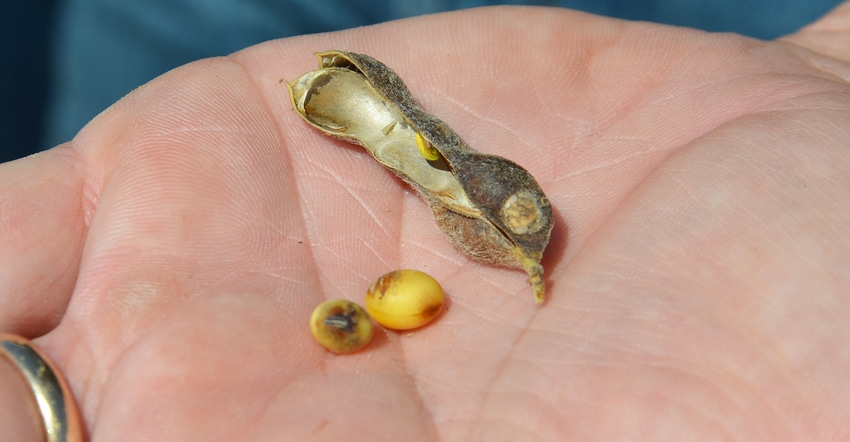
Success in growing crops in 2019 may boil down to who can throw out the playbook and manage by the seat of their pants. Super-late planting topped off by a cool, wet June creates questions about how to manage soybeans now.
Drake Copeland is a technical service manager for FMC. His territory includes eastern Indiana and much of Ohio and Michigan. In the following interview with Farm Progress, Copeland answers question about fungicides and soybean management.
How can fungicides help in a late season? We saw a fair amount of frogeye leaf spot in 2018, and we expect it to be back. This disease causes necrotic lesions on leaves and reduces the amount of leaf area that can capture light for photosynthesis. That limits yield potential. We believe that a fungicide application applied at the right time can preserve leaf area for capturing sunlight.
For example, our company offers a new fungicide, Lucento, which contains two different active ingredients: flurtriafol, Group 3 mode of action, and bixafen, Group 7 mode of action fungicide. Some isolates of frogeye leaf spot are resistant to strobilurin, Group 11 chemistry. Lucento doesn’t contain that chemistry.
Disease specialists talk about applying fungicides with either curative or preventive action, or both. What do you suggest? Lucento has some curative action, but our strategy is prevention of disease through scouting and timely fungicide applications. Once frogeye leaf spot lesions form, you can’t erase them and restore light-capturing capacity. We suggest that whatever fungicides you use, think in terms of preventing infection.
When do you recommend spraying? We normally see the best results with fungicide applied between R3 and R5 as far as yield potential. However, fungicide should be applied at the onset of disease infection. According to the Purdue University Corn and Soybean Field Guide, at R3 there’s a pod at least one-quarter inch long at one of the four uppermost nodes of the main stem.
What we don’t yet know this year is if diseases could appear before soybeans reach R3. Warm, humid weather favors frogeye leaf spot. We’ve certainly had the moisture, but it was cool through June. On the other hand, even late-planted soybeans will flower sooner than normal since the longest day of the year will have already passed. There’s just lots of uncertainty.
We suggest scouting with the goal of spraying at R3. Keep an open mind if you need to adjust.
Other diseases can affect soybean quality too, correct? Yes. Pod and stem blight was an issue in many areas last fall. It can affect both yield and quality. Some people may question investing more money in a late crop. However, if a fungicide can help save bushels and prevent dockage or rejection at the elevator, it’s a factor worth considering.
Realize that a good fungicide has considerable residual life. However, in a year like 2018, when harvest was delayed and beans sat in the field, at some point a disease such as pod and stem blight will cause damage. If you’ve applied a fungicide, you hope it’s less damage than if you hadn’t sprayed.
Are diseases the only concern this year? No, insects, particularly stinkbugs, were a problem last year and could return this year. They can cause so much damage by sucking juices from pods that even if they appear very late, as beans are maturing inside pods, a treatment could be warranted.
About the Author(s)
You May Also Like




